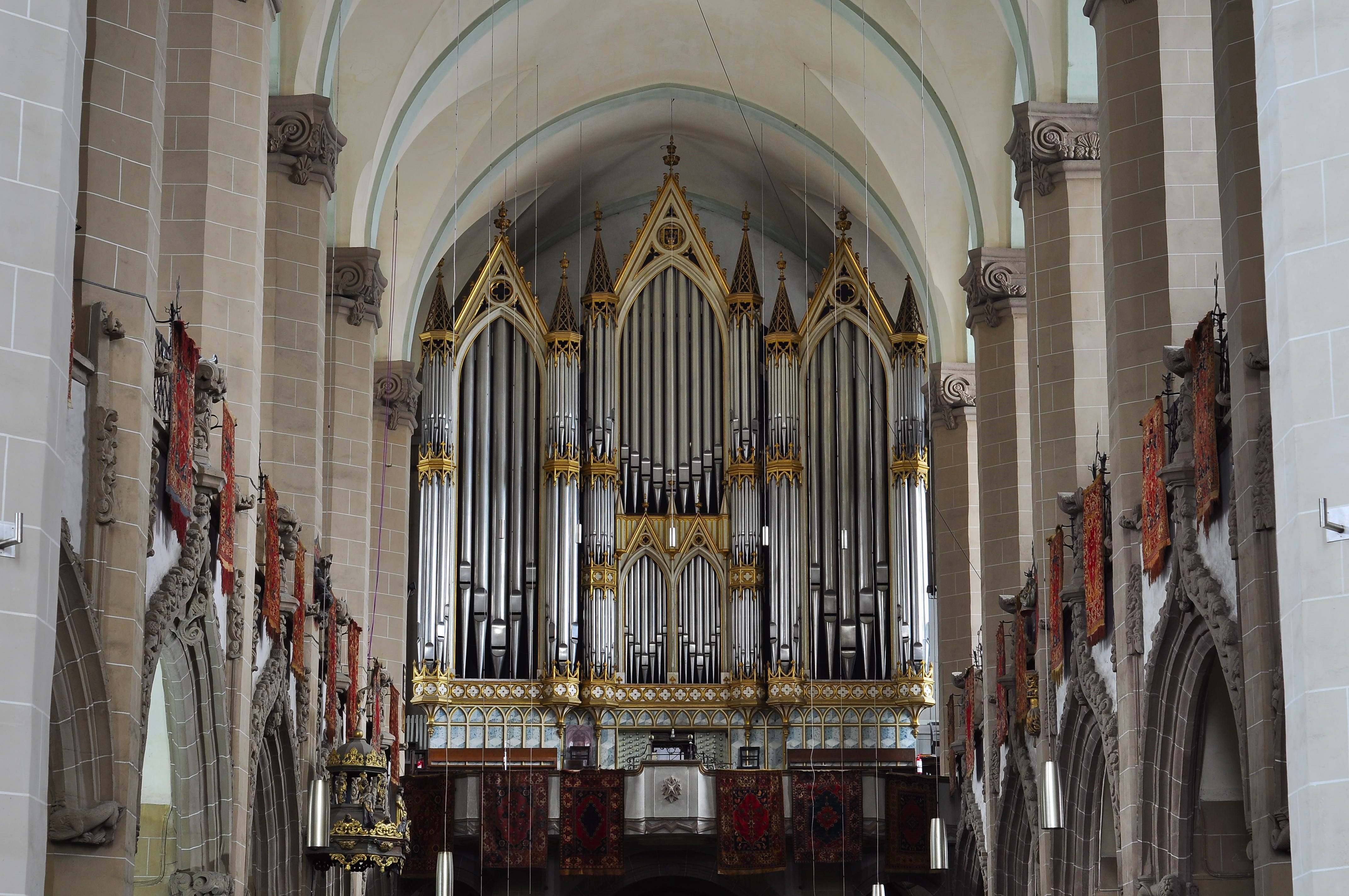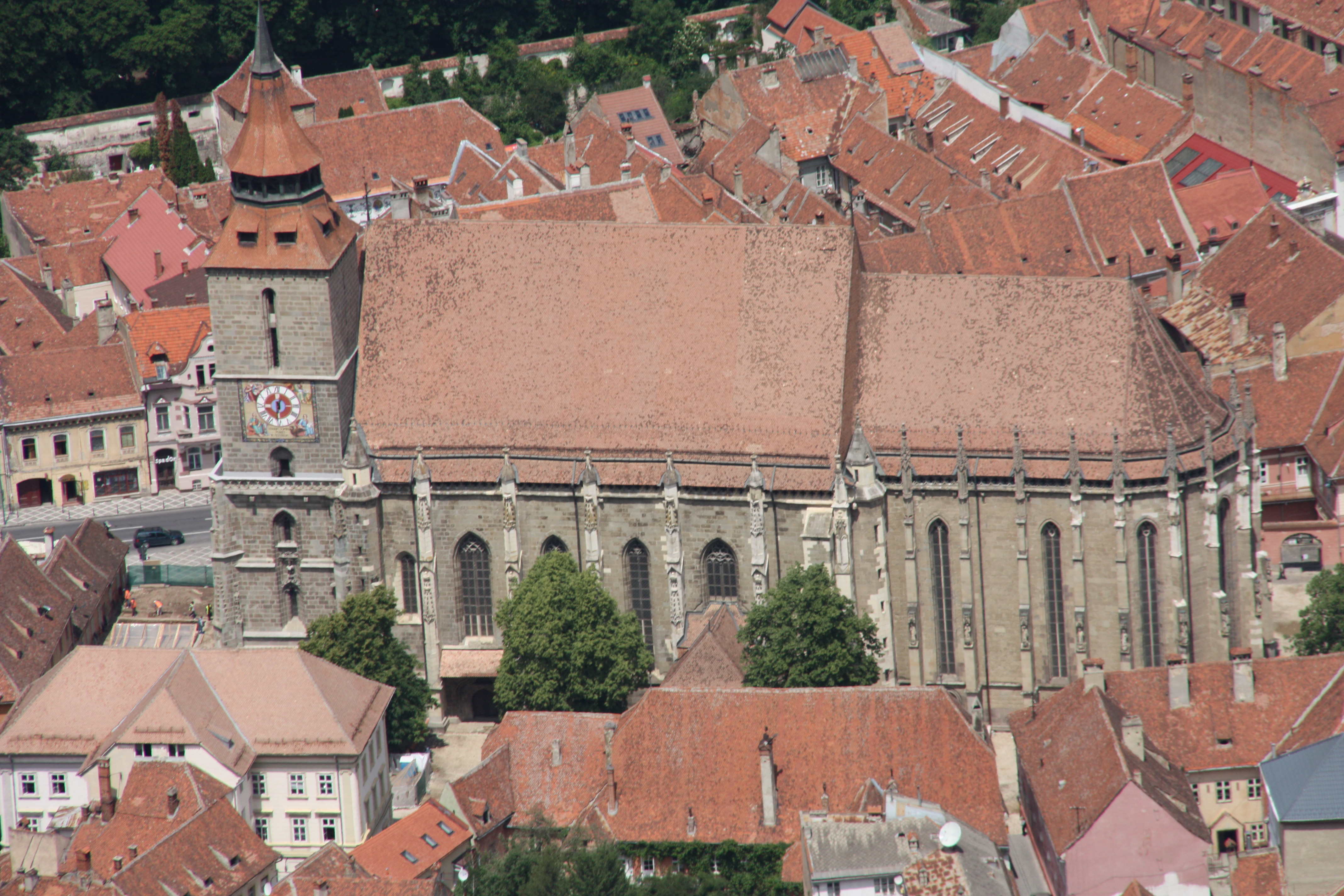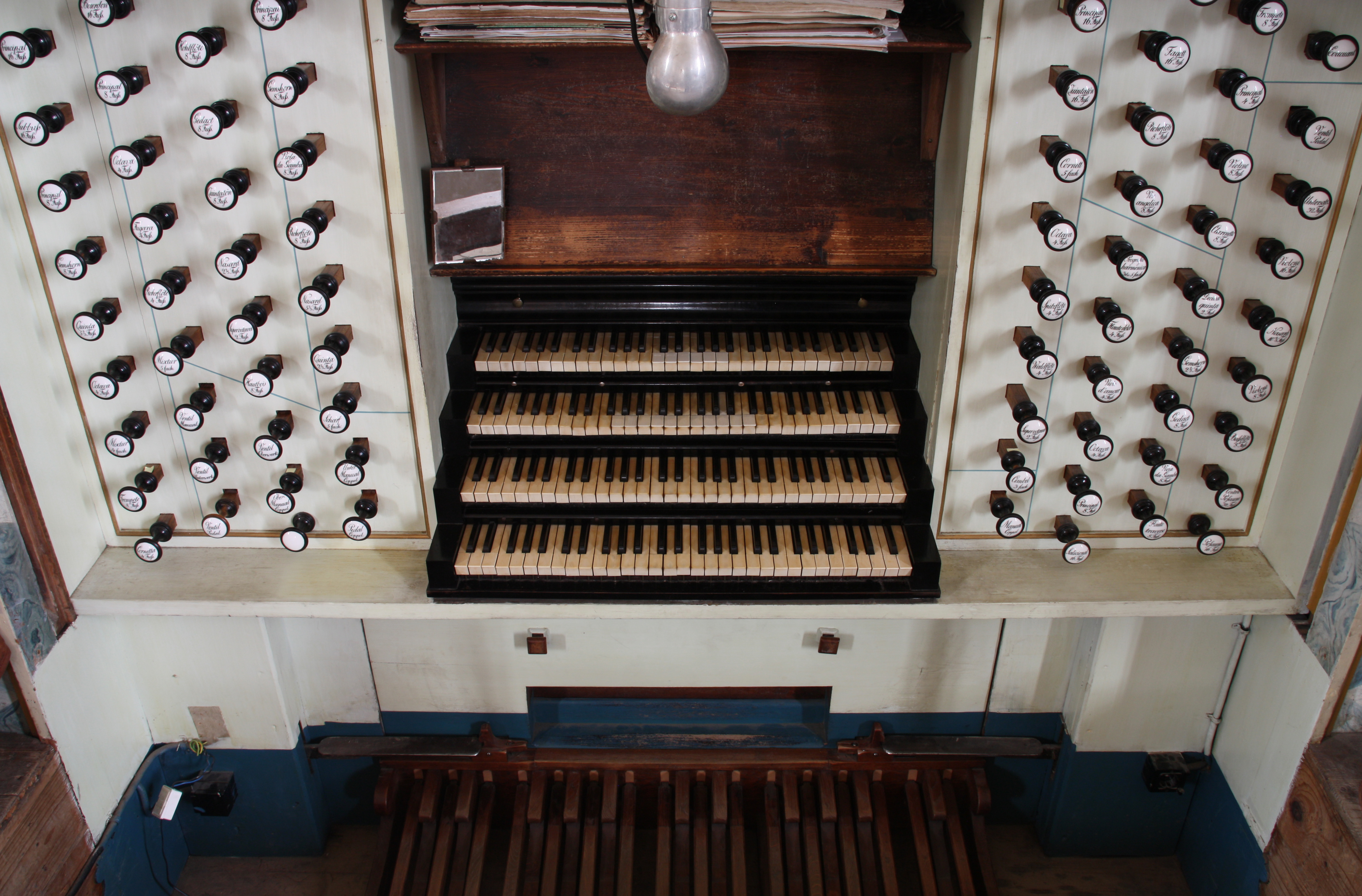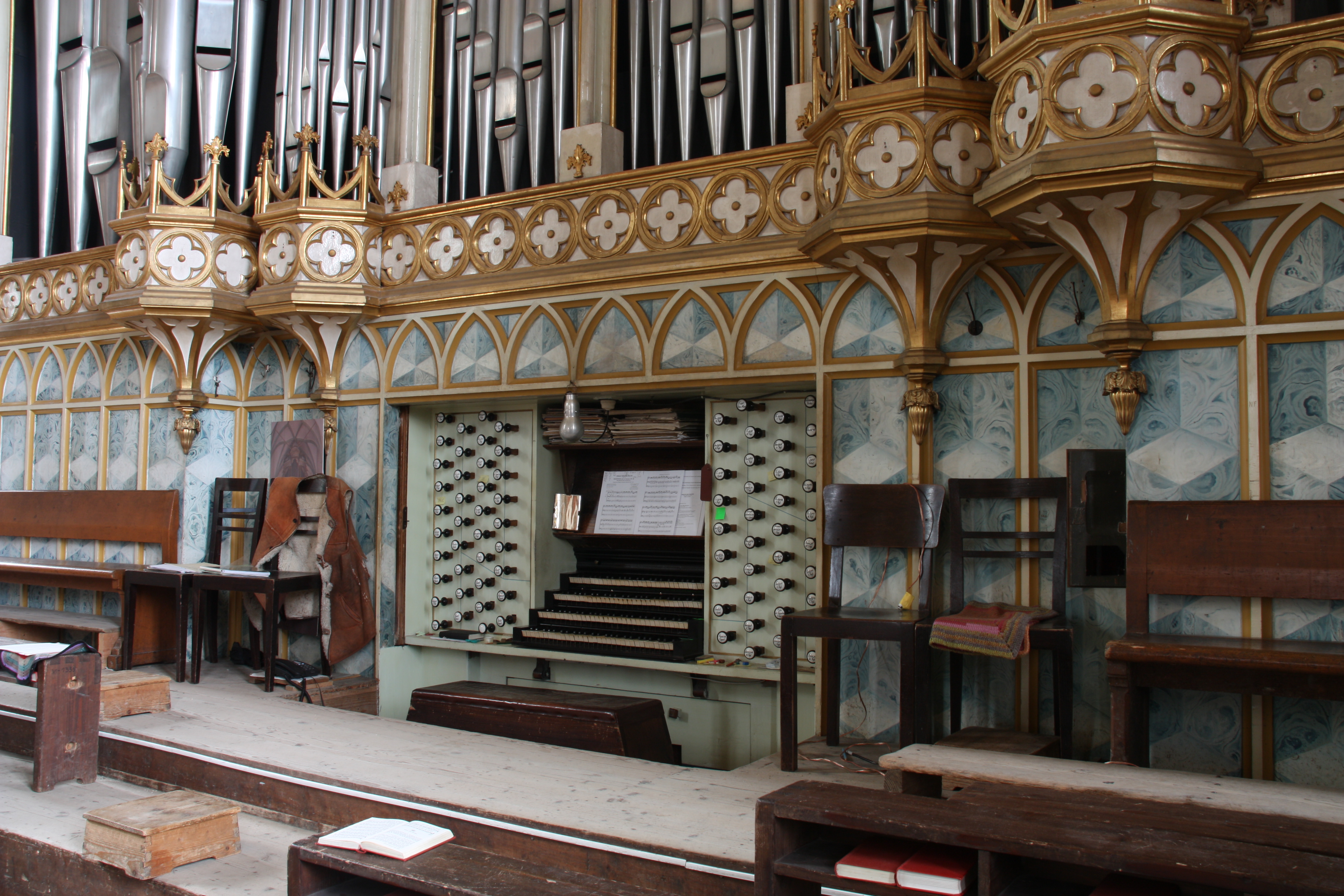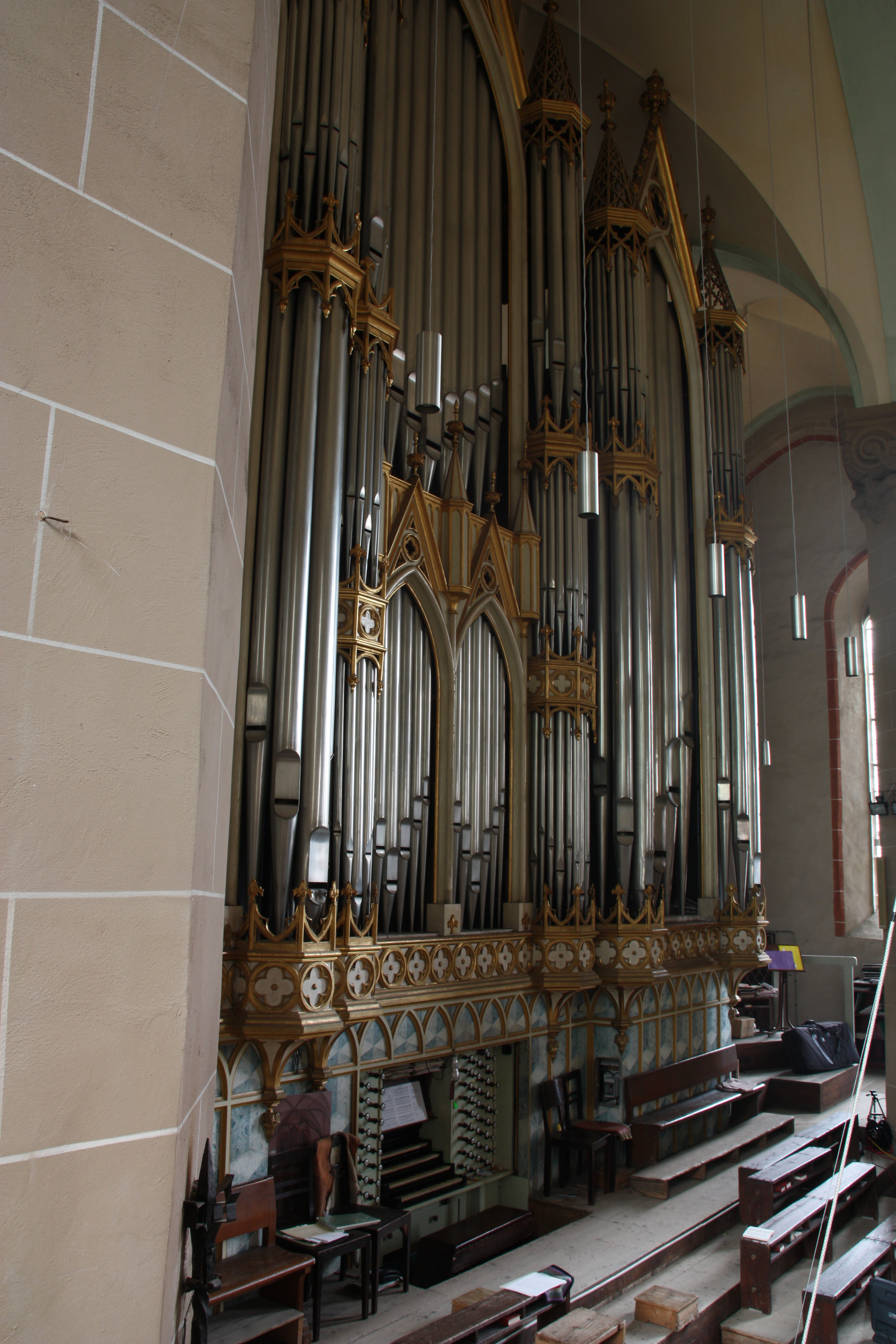Brasov, Biserica neagra
| Builder | C. A. Buchholz |
|---|---|
| Year | ca. 1839 |
| Period/Style | Romantic |
| Stops | 63 |
| Keyboards | 4+P |
| Keyaction | tracker/mechanical |
| Tuning | Equal |
| Sampleset |
Available
 , sampled by
Sonus Paradisi
, sampled by
Sonus Paradisi
|
The instrument is the largest preserved organ by Carl August Buchholz (1796 - 1884), the prolific Berlin organbuilder. It consists of four manual console with 63 sounding stops. The Black church (Biserica neagra, Schwarze Kirche) is a Lutheran church in the heart of the Transylvania (today Romania). Transylvania had German colonists since the 12th century, there is an uninterrupted German Lutheran tradition since the outset of Lutheranism in Europe. Brasov is the centre of this ecclesiastical body. The church is known for its unique collection of historical Turkish carpets which hang all over the walls and everywhere - and they also undoubtedly contribute to the acoustical condition of the Gothic building. The organ is the largest mechanical instrument of Romania. The importance of the instrument is underlined by frequent concerts: from spring to autumn, there are three organ concerts every week.
The type of the instrument is sometimes called "in between the times". It has clear marks of the Romantic sound: domination of 8 feet stops, poly-choric design of divisions, fully developed choruses (flutes, strings, principals, reeds) in every division, strong dynamic contrasts between divisions. Yet, it is still rooted in the baroque organ design with its "Werkprinzip" and pyramidal structure (foundational stops, aliquotes, mixtures). The core of this organ is the Joachim Wagner organ from the Marienkirche in Berlin, organ which Buchholz repaired in 1829. The purely mechanical action operates the traditional slider chests, requiring a good amount of force to play the keyboards.
The organ is physically designed in three floors: the base is occupied by the pedal with the tallest pipes on the very sides of the organ case. The Oberwerk is seated in the floor above in the front, resulting in a direct and present sound. The Unterwerk is behind, enclosed, and it has the characteristics of a true echo division. The upper floor belongs to the Hauptmanual (front) and Rohrwerk (back, enclosed), allowing for somewhat distant, as if mystical, sound from the above. The colors of the stops blend together perfectly, delivering really smooth crescendo where no stop (not even the loudest ones) stands out of the dark and heavy tutti.
The organ was built in 1839 in the early Romantic style. It was preserved without major changes until present. There was a minor renovation in 1966 when several stops were changed:
Hauptmanual Cornett 16 to Cornett 8
Unterwerk Flauto traverso 8 to an Octavlein 1, Progressio Harmonica set to a higher pitch
Pedal Nasard 10 2/3 changed to Octave 2 and Mixtur reinforced by one rank.
The purpose of these changes is clear: to give somewhat brighter detail to the instrument, following the neo-baroque fashion.
During the latest restoration by Ferdinand Stemmer, all the changes were puristically undone to restore the primordial state, because the original pipes were mostly available. Hence, the insrument is now in the shape as it came out of the hands of Buchholz. It is definitely the best preserved Buchholz organ ever.
The type of the instrument is sometimes called "in between the times". It has clear marks of the Romantic sound: domination of 8 feet stops, poly-choric design of divisions, fully developed choruses (flutes, strings, principals, reeds) in every division, strong dynamic contrasts between divisions. Yet, it is still rooted in the baroque organ design with its "Werkprinzip" and pyramidal structure (foundational stops, aliquotes, mixtures). The core of this organ is the Joachim Wagner organ from the Marienkirche in Berlin, organ which Buchholz repaired in 1829. The purely mechanical action operates the traditional slider chests, requiring a good amount of force to play the keyboards.
The organ is physically designed in three floors: the base is occupied by the pedal with the tallest pipes on the very sides of the organ case. The Oberwerk is seated in the floor above in the front, resulting in a direct and present sound. The Unterwerk is behind, enclosed, and it has the characteristics of a true echo division. The upper floor belongs to the Hauptmanual (front) and Rohrwerk (back, enclosed), allowing for somewhat distant, as if mystical, sound from the above. The colors of the stops blend together perfectly, delivering really smooth crescendo where no stop (not even the loudest ones) stands out of the dark and heavy tutti.
The organ was built in 1839 in the early Romantic style. It was preserved without major changes until present. There was a minor renovation in 1966 when several stops were changed:
Hauptmanual Cornett 16 to Cornett 8
Unterwerk Flauto traverso 8 to an Octavlein 1, Progressio Harmonica set to a higher pitch
Pedal Nasard 10 2/3 changed to Octave 2 and Mixtur reinforced by one rank.
The purpose of these changes is clear: to give somewhat brighter detail to the instrument, following the neo-baroque fashion.
During the latest restoration by Ferdinand Stemmer, all the changes were puristically undone to restore the primordial state, because the original pipes were mostly available. Hence, the insrument is now in the shape as it came out of the hands of Buchholz. It is definitely the best preserved Buchholz organ ever.
| Unterwerk (enclosed) | Rohrwerk (enclosed) | Hauptmanual | Oberwerk | Pedal |
|---|---|---|---|---|
| Salicional 16′ | Rohrflöte 8′ | Principal 16′ | Bourdon 16′ | Principal 32′ |
| Principal 8′ | Violino 8′ | Quintatön 16′ | Principal 8′ | Untersatz 32′ |
| Viola da Gamba 8′ | Principal 4′ | Principal 8′ | Salicional 8′ | Principal 16′ |
| Gedact 8′ | Fagott 16′ | Gemshorn 8′ | Hohlflöte 8′ | Violone 16′ |
| Flauto traverso 8′ | Trompete 8′ | Viola da Gamba 8′ | Gedact 8′ | Subbass 16′ |
| Octava 4′ | Clarinetto 8′ | Rohrflöte 8′ | Quintatön 8′ | Nasard 10 2/3′ |
| Flauto dolce 4′ | Vox angelica 8′ | Nasard 5 1/3′ | Octava 4′ | Principal 8′ |
| Viole d'amour 4′ | Octava 4′ | Rohrflöte 4′ | Gemshorn 8′ | |
| Gemshorn 2 2/3′ | Spitzflöte 4′ | Fugara 4′ | Violone 8′ | |
| Decima quinta 2′ | Waldflöte 4′ | Nasard 2 2/3′ | Bassflöte 8′ | |
| Progressio harmonica III–V | Quinta 2 2/3′ | Superoctava 2′ | Quinta 5 1/3′ | |
| Superoctav 2′ | Mixtur V | Octava 4′ | ||
| Scharf V | Hautbois 8′ | Mixtur V | ||
| Cimbel III | Contra Posaune 32′ | |||
| Cornett V (from g) | Posaune 16′ | |||
| Trompete 8′ | ||||
| Cornetta 4′ |
1410663595-Mendelssohn - Prelude and Fugue in G
0:00
0:00
1411121397-Mendelssohn - Praeludium und Fuge d-moll op.37 nr.3 Brasov
0:00
0:00
1410664235-Mendelssohn - Sonata II
0:00
0:00
https://www.sonusparadisi.cz/en/organs/germany/bra.html
 Pipe Organ Map
Pipe Organ Map